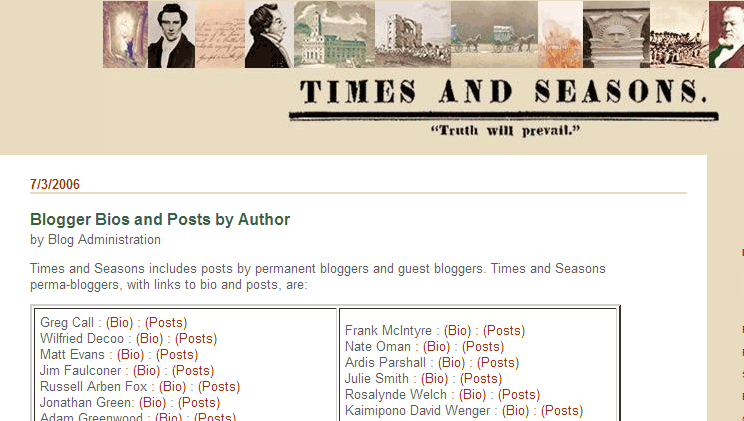Starting Your Own Blog: Tips for Non-profits
Someone wrote me with the following question:
Do you have any links you can send me regarding best practices, research, etc for starting/running a non-profit blog? A writer who works for me has a non-profit foundation and would like to start a blog. We could just start one, but I think we should define our goals and find out what differences (if any) exist between blog-types. Any direction you can provide is appreciated.
I divided my response into three sections.
Comparing Blog Types
For a chart showing the differences between different blogging platforms, see this comprehensive grid from Red Alt. Basically, the most common three platforms are Blogger, Movable Type, and WordPress. Blogger is basic and not as easy to customize. Movable Type is not bad, but since they switched to a paid model, they aren't nearly as appealing. WordPress is completely free, can be customized to the core, and has countless plugins and themes you can apply.
I highly recommend using WordPress. To get started with WordPress, visit www.wordpress.org and see the instruction from the WordPress Codex. I also made a how-to installation video here. You can install it in a subdirectory (such as "blog") within your nonprofit site and link to it, or you can install it in the root and let it be the site.
Best Practices for Nonprofits
As for best tips and practices, here's what I've learned from running http://stc-suncoast.org, the STC Suncoast nonprofit site:
- Blogs are great tools for disseminating information.
- Blogs are easy to set up, and you can share the publishing tasks with others.
- You can easily add additional functionality to your blog (for example, comments, chat, podcasts) that isn't so easy with a traditional website.
However, there are some drawbacks to using a blog:
- You (and maybe a couple of others) may be the only ones publishing anything to the blog.
- It may take you a while to figure out how to customize some aspects of your blog.
- A communal blog does not a community make. In other words, just because you create a highly interactive site, it may not create any more community than the previous static site. It's what you do with the tool that makes the difference.
With nonprofit sites, you don't have to worry much about dissatisfied customers ranting in comments. Nor do you have to worry much about legal consequences surrounding the content. It is less risky.
Defining Your Goals
Defining your goals is always a good idea. My goals with the STC-Suncoast site were to create an interactive medium where members could post and comment, exchanging ideas as a true community of users with aligning interests. I have seen this done really well on the Times and Seasons blog—a thought-provoking religious blog for the Latter-day Saint community. In fact, the popularity and interactivity of Times and Seasons gave me the original motivation to convert our chapter site into a blog.
as a true community of users with aligning interests. I have seen this done really well on the Times and Seasons blog—a thought-provoking religious blog for the Latter-day Saint community. In fact, the popularity and interactivity of Times and Seasons gave me the original motivation to convert our chapter site into a blog.
However, after the Suncoast blog was implemented, I was a little frustrated when no one really posted much. If I were you, I would first gather a group of enthusiastic people interested in sharing with each other. If you have 8-10 dedicated authors, each of which commits to posting once a week, you can have a highly successful non-profit blog. The quality of authors is impressive on Times and Seasons. It's a mix of Harvard lawyers, philosophy professors, and other really smart people. At one time I attempted to gather a group of dedicated bloggers for the Suncoast chapter blog, but they all faded.
There are other factors that determine whether a community takes off. I am still not sure why our chapter model did not succeed like Times and Seasons. One fact may be the topical differences between the blogs; another may be that Times and Seasons is a distributed community where users gather of their own choosing. An STC chapter blog has members grouped by physical location; many belong to the STC for other purposes, and may not be interested in interacting as a community.
So this is my most important tip: If you want to establish a community with your blog, you need a core group of dedicated bloggers.
If anyone else has tips to add for this reader, please add your comment below.
About Tom Johnson

I'm an API technical writer based in the Seattle area. On this blog, I write about topics related to technical writing and communication — such as software documentation, API documentation, AI, information architecture, content strategy, writing processes, plain language, tech comm careers, and more. Check out my API documentation course if you're looking for more info about documenting APIs. Or see my posts on AI and AI course section for more on the latest in AI and tech comm.
If you're a technical writer and want to keep on top of the latest trends in the tech comm, be sure to subscribe to email updates below. You can also learn more about me or contact me. Finally, note that the opinions I express on my blog are my own points of view, not that of my employer.
